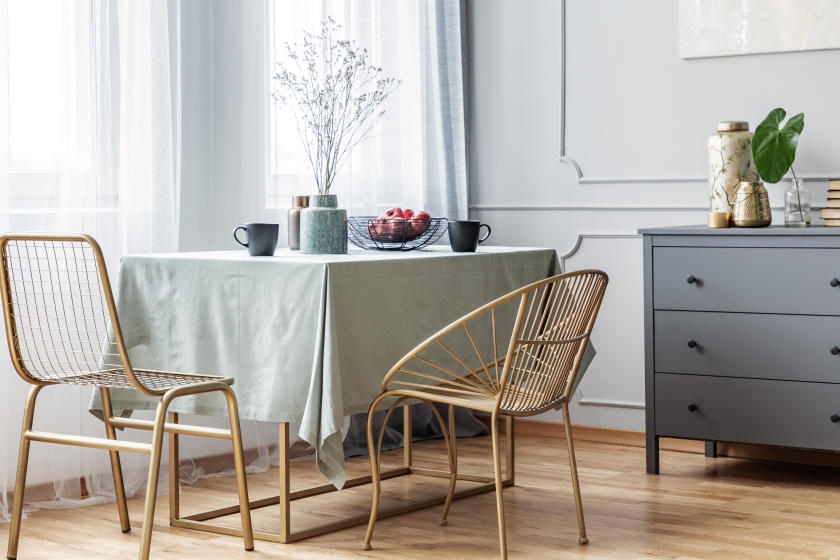If your furniture is looking worn, or you want a new look but don’t want to buy new furniture to get it, try recycling what you have by painting it.
Paint Wood Furniture
As wood ages, it can turn dark, dull and lifeless. Older wood finishes are generally weaker than the advanced finishes we use today so they need more protection than newer pieces. Your furniture may have lost its luster, but you can give it a restored, polished look in just a few simple steps.
Step 1: Repair
If your furniture is structurally sound and designed well, simply remove the old finish and start painting. Even if your furniture seems hopeless, it can be brought back to life with a little tender loving care and extra attention. Your furniture repairs may be as simple as using a few nails or screws, a hammer or screwdriver and some wood glue.
Step 2: Prepare Your Work Area
Select a well-ventilated work area such as a garage or outdoor deck. Make sure your furniture refinishing area is dry and free of dust. Use masking tape to secure newspaper or a large drop cloth to the floor to protect it from spills. Remove drawers, doors, mirrors and any hardware.
Safety Alert!
Stripping chemicals and stains are extremely flammable and can ignite so never refinish near an open flame.
Step 3: Remove Old Finish
Scrape loose varnish by sanding and/or using chemical strippers. To remove finishes quickly from larger areas, use a belt sander. Take care not to damage the piece by sanding too deeply. Sand carefully by hand around decoratively curved areas such as turned table legs.
Chemical strippers are an easier method but read the manufacturer’s directions carefully before applying. Use a medium-sized paintbrush to apply the solution evenly over the surface. Let it soak for 20 to 30 minutes and then remove the old finish using a plastic scraper or a smooth, round-edged putty knife. The surface may be soft so be careful not to damage it with the scraper. Allow the piece to dry completely.
Safety Alerts!
Always wear rubber gloves and protective goggles when using strong chemicals.
Always wear gloves and protective goggles and a dust mask while sanding.
Be sure your work area is well ventilated.
Helpful Tips
Use chemical strippers clearly marked “no clean-up” or “will wash away with water.” The “no clean-up” type strippers may leave a residue, however, which must be sanded away. Residue from the “wash away” type can be removed by rinsing with water. Be aware that water may raise the grain of the wood. Lightly sand to reduce this effect.
Heat guns can be used as a supplement to other methods to remove particularly stubborn finishes.
Step 4: Sand
The more thorough you are during the stripping process, the less you’ll need to sand. Start sanding with medium-low grit sandpaper to clean off any finish that remains and smooth out any imperfections in the wood. Then smooth the whole piece down with fine-grit sandpaper. Be sure to sand along the grain of the wood. Do this carefully as any swirl marks caused by sanding will stand out when you stain. Remove sawdust with a hand vacuum, brush or soft cloth.
Safety Alert!
Always wear gloves, protective goggles and a dust mask when sanding.
Step 5: Apply Primer
Use a paintbrush (brush size depends on the size of the area you’re covering) to apply a coat of white or gray water-based primer, such as True Value EasyCare Ultra Premium Interior Primer/Sealer. It’s a good idea to have your primer tinted the same color as the paint you plan on using. Using tinted primer will reduce the number of paint coats. You can also use a True Value brand spray-on primer.
Allow the primer to dry for up to 2 hours, or for as long as recommended by the manufacturer’s instructions. Feel the furniture’s surface for any rough spots and sand lightly if necessary. Apply a second coat. Let the primer dry for approximately 12 to 24 hours.
Step 6: Paint
Apply a water-based paint, such as True Value EasyCare Ultra Premium Interior Paint, with a quality paint brush. Brush it on with even strokes in the direction of the wood grain. If you use True Value spray paint, go slowly, holding the can about 12″ from the furniture surface. When using spray paint, you should apply the second coat within 1 hour or after 24 hours. Let the second coat dry overnight.
Helpful Tip
To get the most out of your paintbrush, use a brush comb to separate bristles that stick together near the heel of the brush when cleaning. Rinse the brush in either water or paint thinner. When it clears, put the brush in a spinner or thoroughly shake out excess liquid. Put the brush back in its protective sleeve or hang it on a nail or hook.
Safety Alert!
Don’t pour used paint thinner down the drain. Some states don’t even allow it. Find out where and how you can dispose of it properly.
Paint Metal Furniture
Metal furniture, whether used inside or outside, can be revived as well. The process is essentially the same as with wood furniture except you’ll use a different kind of paint and primer. Follow the steps below to revamp your metal pieces.
Step 1: Clean and Prepare
Clean the metal surfaces of dust or debris with detergent, water and a scrub brush or rag. If any mold is present, remove it with a bleach and water solution. Remove any rust with a wire brush or sandpaper. For more stubborn rust spots use a chemical rust remover. Scrape any flaking paint with the wire brush and sand down any rough areas with heavy-grit sandpaper.
Safety Alert!
Always wear gloves, protective goggles and a dust mask when sanding. In addition, wear gloves and protective goggles when using chemicals.
If the furniture you’re working on has non-metal surfaces, such as a seat on a chair, remove them if possible. If they cannot be removed, cover the surfaces with newspaper or plastic and masking tape to prevent any unwanted damage.
As you would with wood furniture, choose a good spot to do the job. Cover the floor with tarps, drop cloths or newspaper to avoid any headaches caused by accidental spills and make sure there’s adequate ventilation.
Step 2: Apply Primer
Use a small or medium paint brush to cover the metal surface with True Value EasyCare Ultra Premium Interior Primer/Sealer that protects against corrosion and rust. Let the primer dry for a day. If possible, use a primer that is the same color as the paint you’re going to use. This will cut down on the amount of coats when you paint.
Step 3: Paint It
You can paint metal furniture a couple of ways. There are several excellent True Value spray paints available that are formulated for use on metal furniture. Follow the directions on the can and hold it approximately 12″ from the painting surface to get a balanced and consistent coat. If you brush on the paint, use a quality, small or medium-sized paintbrush. Apply two coats for a long-lasting finish. Allow the paint to dry for at least 24 hours before using your furniture.
Paint Plastic Furniture
Step 1: Prepare for Painting
Wash plastic furniture thoroughly with detergent, hot water and a rag, sponge or soft brush. If furniture has been outside for a long period of time or has stubborn stains, use a cleaner with ammonia. Let it dry.
Cover non-plastic surfaces, such as metal chair legs, with masking tape. Choose a good workspace with plenty of ventilation and cover the floor with drop cloths or newspaper.
Step 2: Paint
Apply a thin coat of EasyCare Premium Decor Spray Enamel by holding the can at least 12″ away and spray in a sweeping motion. Let the paint dry before applying another coat. The amount of coats you will need will depend on the piece of furniture itself and your own personal judgment. When you’re happy with the paint coverage, let the furniture dry for at least 12 hours. Remove the masking tape after the paint has completely dried.
Nice job! Now sit back and admire your newly updated furniture.
Wood Furniture: Project Shopping List
Here’s what you’ll need to complete this project successfully.
- Nails
- Screws
- Hammer
- Wood glue
- Masking tape
- Newspaper
- Drop cloths
- Sandpaper
- Chemical stripping solution
- Belt sander (optional)
- Medium-sized paintbrush
- Plastic paint scraper
- Putty knife
- Rubber gloves
- Protective goggles
- Heat gun (optional)
- Medium-low grit sandpaper
- Medium-grit sandpaper
- Hand vacuum
- Soft brush
- Soft cloth
- Gloves
- Dust mask
- Paintbrushes
- EasyCare Ultra Premium Interior Primer/Sealer
- EasyCare Ultra Premium Interior Paint
- X-O Rust Paint and Primer In-One
- Brush comb
- Storm windows
- Spinner
Metal Furniture: Project Shopping List
Here’s what you’ll need to complete this project successfully.
- Detergent
- Bucket
- Scrub brush
- Rag
- Bleach (optional)
- Wire brush
- Fine-grit sandpaper
- Chemical rust remover
- Heavy-grit sandpaper
- Plastic (optional)
- Masking tape (optional)
- Tarps
- Drop cloths
- Newspaper
- Small or medium-sized paintbrush
- Brush comb
- Storm windows
- Spinner (optional)
Plastic Furniture: Project Shopping List
Here’s what you’ll need to complete this project successfully.
- Detergent
- Bucket
- Rag
- Sponge brush
- Soft brush
- Ammonia-based cleaner (optional)
- Masking tape
- Drop cloth or newspaper (optional)












